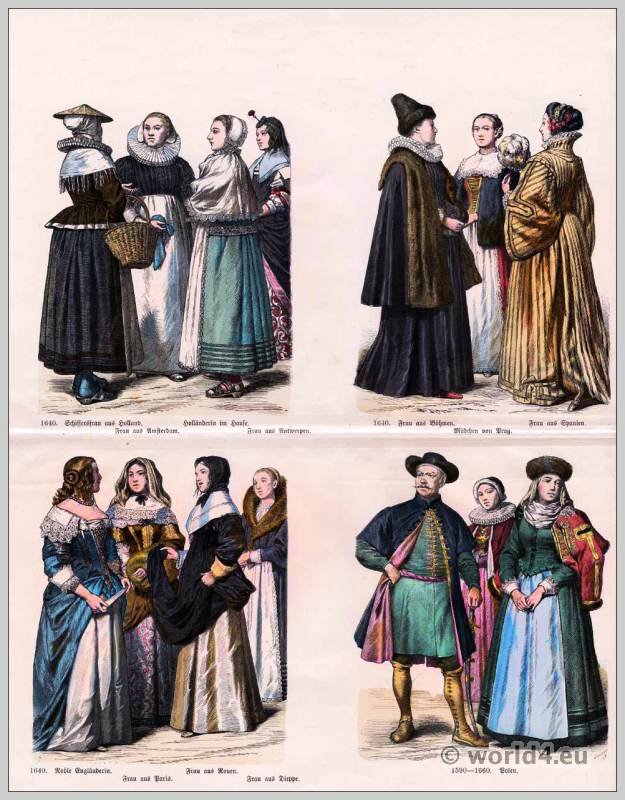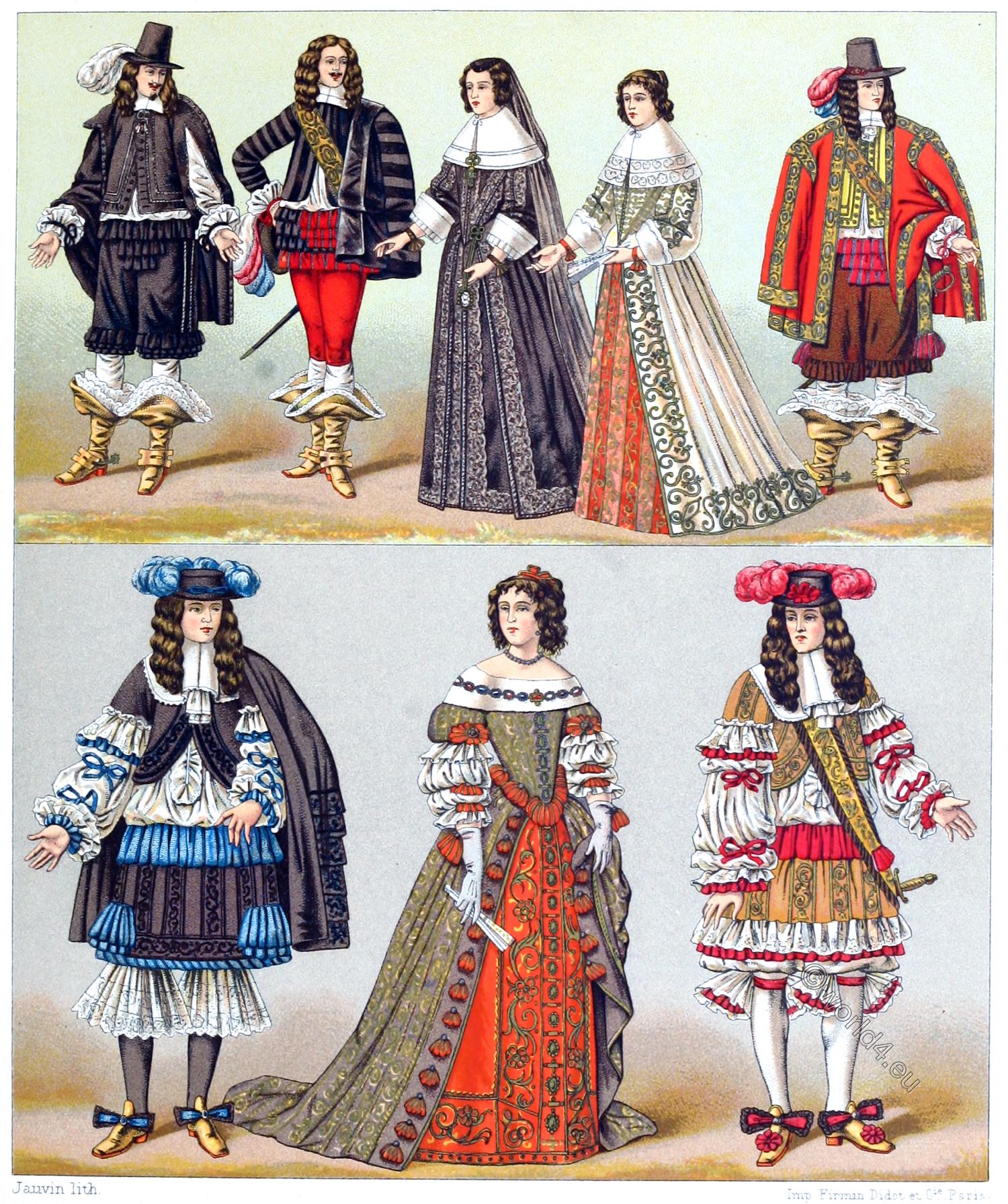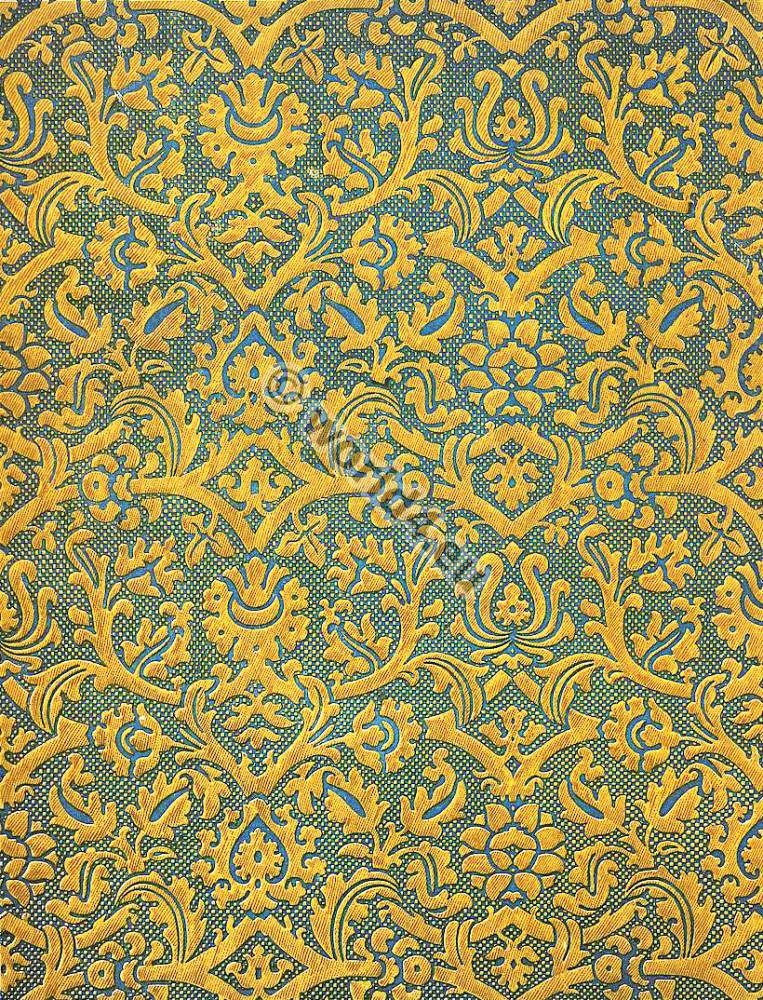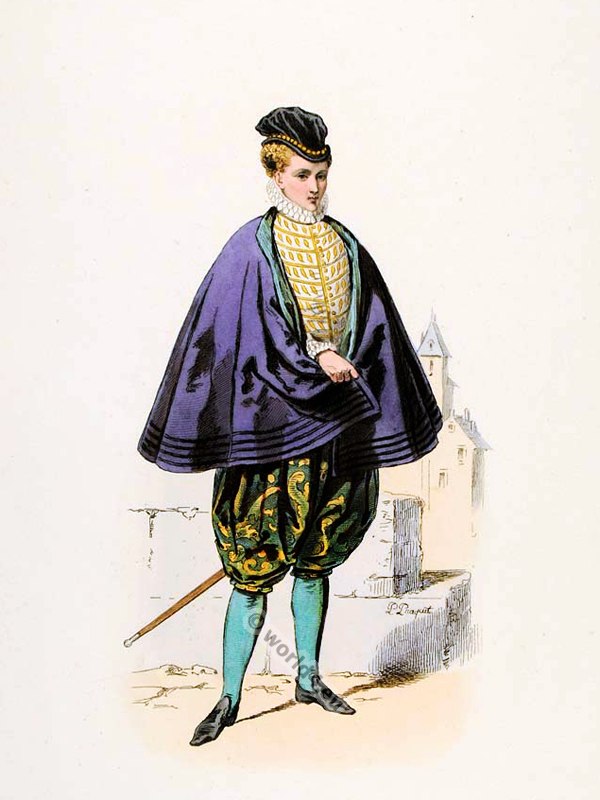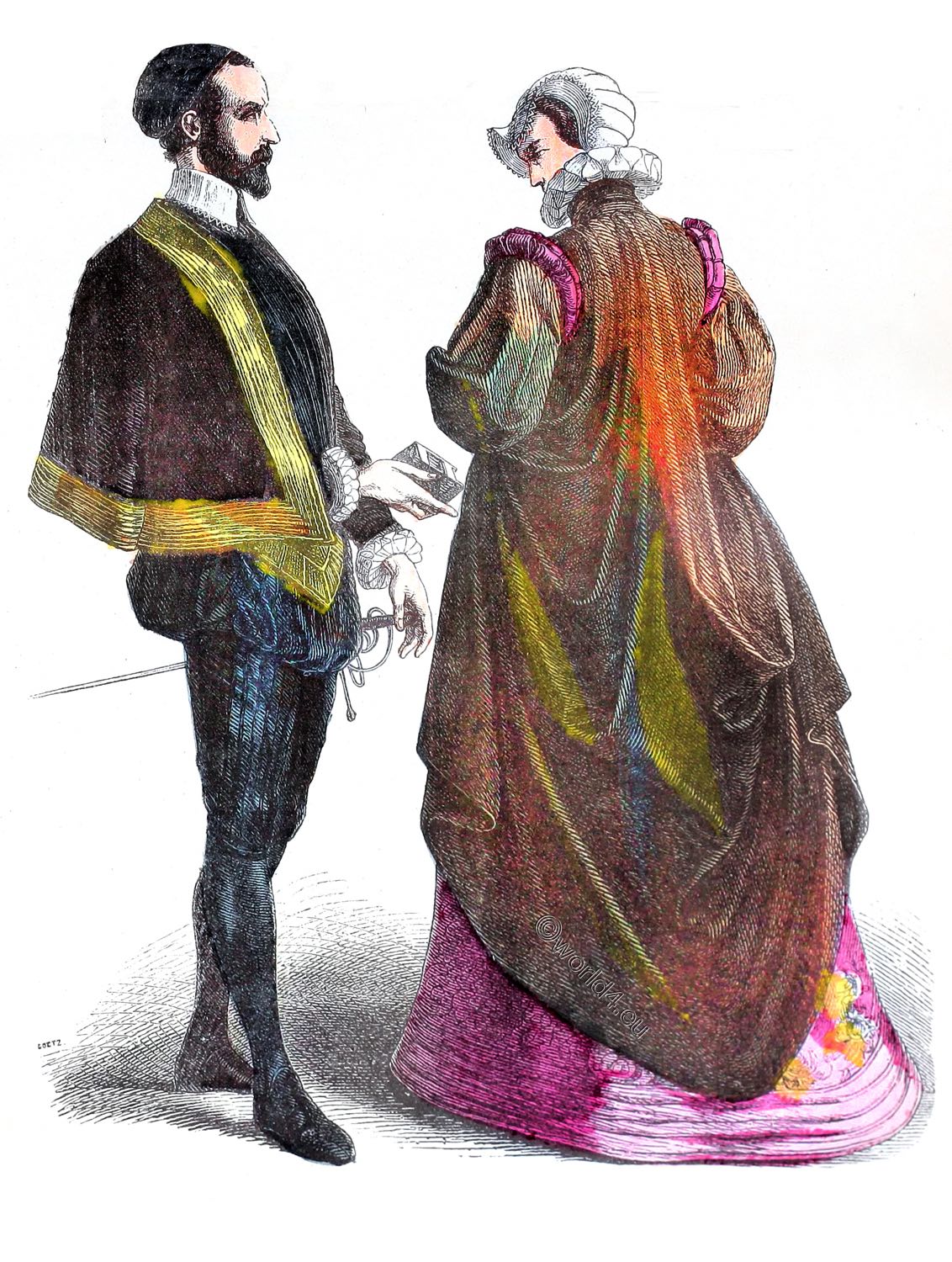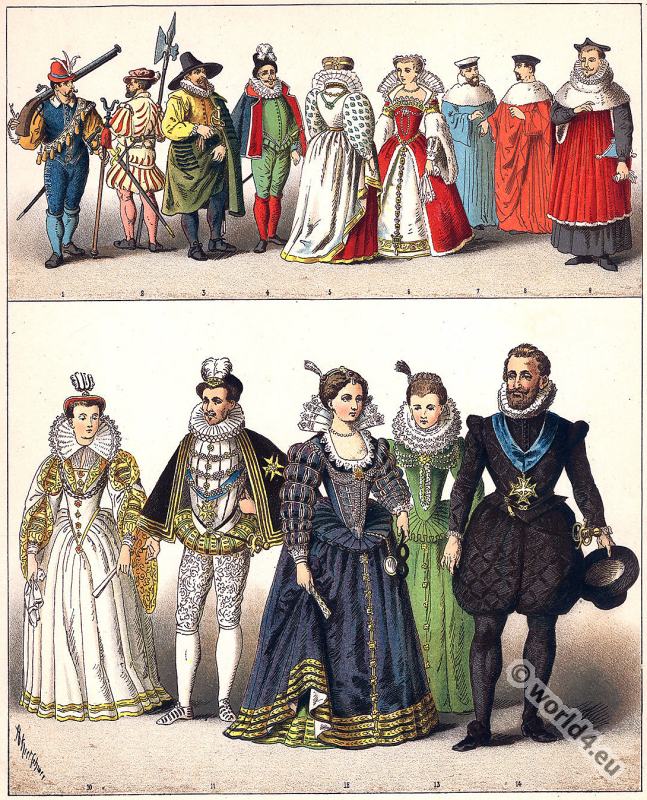
Figures:
1 2 3 4 5 6
7
16TH AND 17TH CENTURY FRANCE.
COSTUMES OF THE NOBILITY IN THE TIME OF KING HENRY IV.
COURT TOILETS AND CEREMONIAL ROBES.
No. 2 – Margaret of France, Queen of Navarre, first wife of King Henry IV. Even before the death of Henry III, the misery of the population during the battles of the League had diminished luxury, but without exerting much influence on the essential character of fashion.
The waist bulge, the puffed sleeves separated from the low-cut bodice, the fan-shaped neck collar, the folded-back cuffs, the hair taken up to a moderate height above the crown, the petticoat different in colour from the closed overdress form the costume of Queen Margarethe in 1605.
The whole toilet gives the impression of austerity with its contrast of black and white. Each of the sleeve and bodice slits bears a gold button. A bow on the bodice closure at the height of the chest, a gold star with gems in the front of the hair, a pearl in the ear, a string of pearls around the neck serve as jewellery.
No. 1 and 5 – Henry IV before 1600.
The men’s costume underwent great changes at this time. The laced bodice was replaced by the unlaced doublet with epaulets à la Henri IV. The neck fraises became smaller, and in their place gradually came the rebate, the turned-down collar. All trousers were puffed; the so-called grègues were long and had the biggest bulge in the middle; the trousers à bourse were short and went down widening to the stocking.
The cape was given its old cut again and became a shoulder cloak, which was draped over one arm and the chest. The high Alba hat of the Liguists was replaced by a low hat with a slight widening towards the top or the Castor à la Henry IV with a wide brim. The shoe with a rather high heel was blackened and decorated with a rosette. One preferred the black or yet the dark colours.
Henry IV renewed the luxury laws every five years, but did not fail to see to it that the silk industry flourished, so that to show oneself a nobleman one had to wear velvet, since silk and taffeta had become the fabric for bourgeois garments.
No. 1 shows Henry IV in a bare head, with the sword and the ribbon of the Order of St. George. He is dressed in black, his long trousers are embroidered and slit. His costume corresponds to the one he used to wear at the reception in the Louvre.
No. 5 depicts Henry IV, hat on head, without rapier with the cane and the ribbon of the Order of St. George. Purple stockings, otherwise black with blue garnished slits. Trousers à bourse.
No. 4 and 6 Antoine of Saint-Chamand, Lord of Méry-sur-Oise.
No. 6 wears tulle fraise and cuffs. Black embroidered doublet and grègues. White garters with a bow at the side, fastened above the knee. White ribbon knots on the trousers and the same ribbons on the blackened shoes. Silver epee hilt and scabbard point. Gilt belt.
On No. 4 the same nobleman wears turned-down collar and cuffs; sleeveless doublet with epaulets, the arm clothed with the sleeve of the waistcoat, of silver-embroidered cloth. Trousers à bourse. The main colour is black. The sole of the shoes is studded on the sides with silver nails. The belt is a white ribbon with gold buttons and buckle.
No. 3 – Nobleman after the fashion of 1605. Low hat, collar and cuffs turned down. Predominant colour grey. Doublet and trousers without slits, embroidered in black. Coat with gold embroidery, also the belt. The harness is separated from the latter, the rapier is held in a horizontal position by a white, gold-embroidered bow.
No. 7. Coronation of Marie de’ Medici (1575–1642) on May 13th, 1610, after the painting by Rubens in the Louvre.
The grouping of the picture does not comply with the rules of etiquette, but it is probably suitable to give an idea of the splendour of the costumes. The fragment given here shows the Queen kneeling before the Cardinal de Joyeuse, with the Dauphin (Louis XIII) and his sister Elisabeth at her side.
The long train of the mantle is carried by the Princesses Conty, Montpensier and de Guise. The Duke of Ventadour holds the sceptre, the Chevalier de Vendôme the Hand of Justice. Then Marguerite de Valois, the first wife of Henry IV and the eldest princess of France.
Around the neck of the ladies is the large fan-shaped collar of Italian or Flanders lace, held by a wire frame, starting from the corset. A low-cut bodice, a puffed shirt, a small pearl necklace, a corset protruding to the front, puffed sleeves divided into several parts, a drum-like but moderate bulge at the hips form the costume of the ladies around 1610. The gloves were worn without putting them on.
The Chevalier de Vendome wears his hair longer on one side than on the other. The double collar is turned down. A bandolier-like sash is visible over the doublet of gold fabric. The coat is draped over one arm and the chest. The introduction of high leather boots with spurs into the ceremonial costume is new. Having become fashionable in England in 1606, they were even worn at balls in France from 1608.
The length of the train was determined by the rank of the ladies who wore it, even on horseback it was maintained. For the queen, the length of the same was 9 cubits, for the princesses of France 7, for the princesses of royal blood 5, for the duchesses 3 cubits (A cubit was about 48 centimetres). Queen Elisabeth of Austria wore one 20 cubits long when she entered Paris in 1571. The train of Marie de’ Medici, made of blue velvet, lined with ermine and embroidered with golden fleurs-de-lis, was so heavy that she had to be supported by two noblemen, and that another nobleman assisted the three ladies destined to carry it, by special order of the King.
Nos. 1, 2, 3, 4, 5 and 6 from the Gaignières Collection in the Museum of Prints and Drawings of the National Library in Paris. No. 7 Fragment of the Coronation of Mary de Medicis, painting by Rubens in the Louvre in Paris.
Cf. Les hommes illustres et grands capitaines français, qui sont peints dans la galerie du Palais-Royal, 1690. Quichemt, L’histoire du costume en France.
Source: History of Costume in Chronological Development by Auguste Racinet. Edited by Adolf Rosenberg. Berlin 1888.
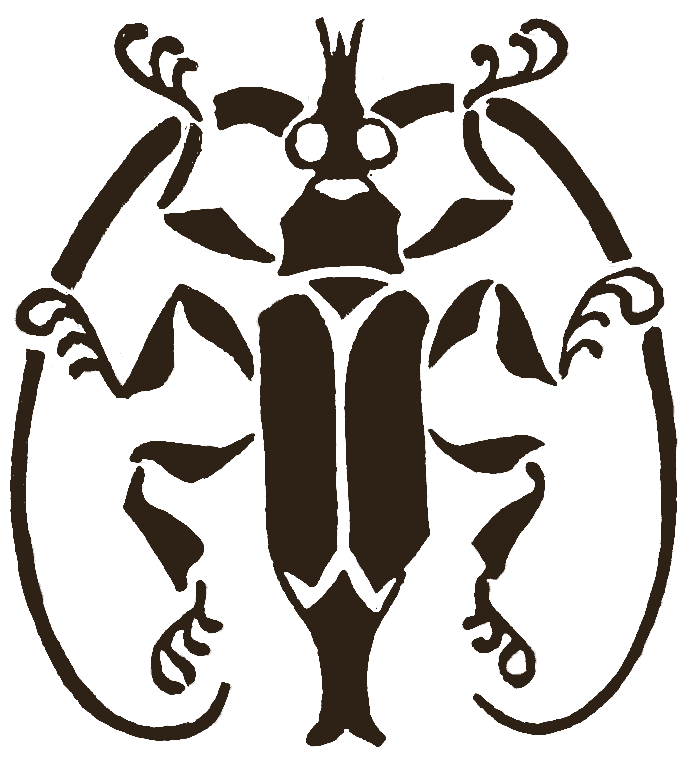
Continuing
Discover more from World4 Costume Culture History
Subscribe to get the latest posts sent to your email.

